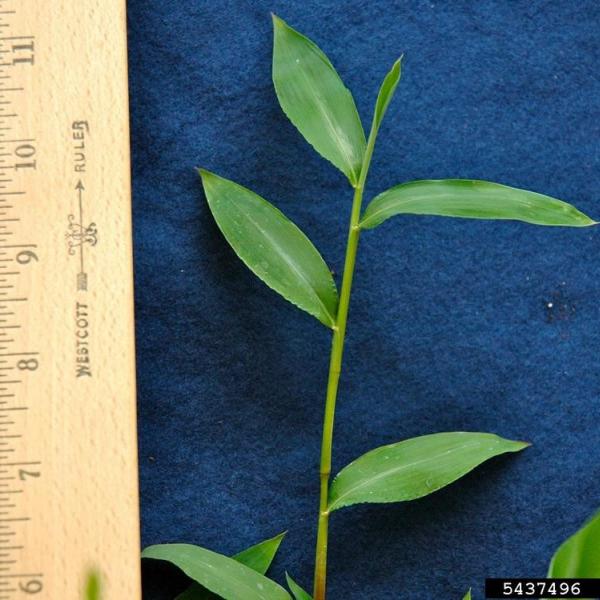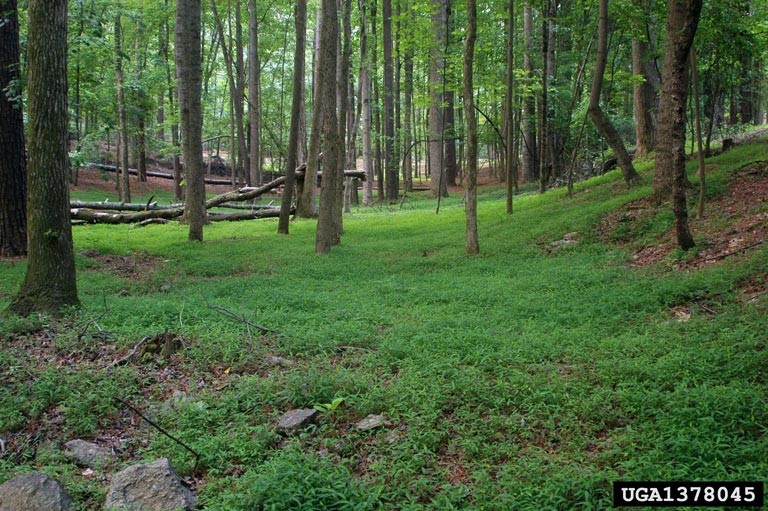
In the Forest Insect and Disease Conditions Report for 2019, we shared that an isolated patch of what was suspected to be Japanese Stiltgrass (Microstegium vimineum) was reported in Sandgate in late 2018 (Bennington County). At the time, there had not been botanical confirmation of the presence of that plant, because the site was treated as part of a private land management project. A potential roadside site for this plant was reported in October 2019 in Brattleboro (Windham County). It was previously thought to be absent from Vermont, but these recent sightings provided by the public through the Report It feature on VTinvasives.org, have led the Vermont Natural Heritage Program to photographically confirm the populations in Bennington, Rutland, and Windham County, but do not have vouchers.
This very invasive plant (an actual classification allotted by the New York Invasiveness Ranking, is also known as “Nepalese browntop”, and can be found in forests, roadsides and lawns, meadows and fields, floodplains, shores of rivers and lakes, and in disturbed habitats. The first record of this species in the U.S. was from 1918 in Tennessee. The initial spread of this plant across the US was thought to have been accidental introductions in packing material, and has since spread to over 25 U.S states. This annual grass, which reaches heights of 1-4 feet, is native to Japan, Korea, Malaysia, India, China, and the Caucasus region.
Leaves are light green blades, one to three inches in length, and arranged alternately on the stem. Each stem can grow 1-3 feet tall. Each blade is held onto the stem with a leaf sheath, and where the sheath meets the stem will have little white hairs. A distinct identifying characteristic is the silvery stripe of reflective hair down the middle of each blade. Common look-alikes, like White Cut Grass (Leersia virginica), lack this silvery stripe on the blade.

Japanese Stiltgrass infestation
The primary mode of spread is through water, and wildlife and human activity moving the prolific number of seeds (100 -1,000 per plant, thought to remain viable up to 7 years in the soil). However, the plant can grow vegetatively, creating localized monocultures of densely matted vegetation. This is an annual that dies back each fall, and that matted layer of thatch does not decompose quickly. While not as flashy as ‘Asian Giant Hornets’, this grass is known to impede the regeneration of native woody species, is shade tolerant and a habitat generalist.
This is still considered an early detection species of concern. Its ability to grow in a variety of conditions (habitat generalist, shade-tolerant), prolific seed production, and fast, dense vegetative growth, mean this plant can spread rapidly. That rapid and dense growth means that stiltgrass can smother other understory vegetation including native woody forest species. The environmental impact it has had in other New England states has led to its listing on the unofficial Vermont Watchlist.
If you find Stiltgrass growing in Vermont, please report it using the Report It Tool.
To learn more about Japanese Stiltgrass, check out www.VTinvasives.org and these additional resources:
CABI – Center for Agriculture and Bioscience International
North Carolina State Cooperative Extension
Penn State Cooperative Extension
Rutgers University Cooperative Extension
Photo Credits:
(Top Right) Japanese Stiltgrass stem, showing silvery midrib, and alternating leave arrangement: Bruce Ackley, The Ohio State University, 5437496, CC 3.0, Bugwood.org
(Bottom Right) Japanese Stiltgrass infestation: Chris Evans, University of Illinois, 1378045, CC Non-com 3.0, Bugwood.org